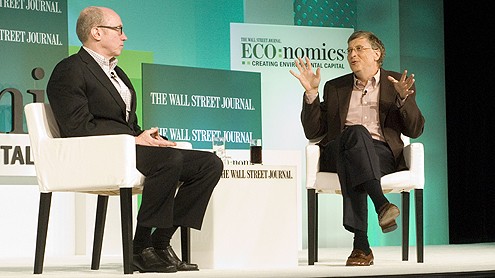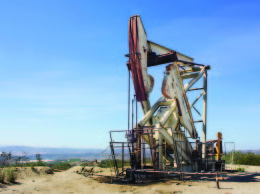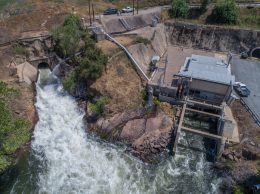
Microsoft founder Bill Gates, right, spoke with the Wall Street Journal's Alan Murray about his vision for a nuclear-led clean energy future at the annual Eco:nomics conference in Goleta.
Microsoft founder Bill Gates is placing his chips on nuclear technology these days — even as he’s skeptical about the time horizon for a fossil fuel-free world.
Gates, who has about 6 percent of his personal money in energy technology, said that he’s investing in fourth-generation nuclear research but doesn’t expect the world to draw the majority of its energy from clean sources within the next 75 years.
“People underestimate how hard it is to make these changes. They look at things that are deeply subsidized. They look at the richest areas and not low-income areas. I think it’s way harder than many people think,” he said.
Gates spoke at the Wall Street Journal’s annual Eco:nomics conference in Goleta on March 22.
He is one of the primary investors in fourth-generation nuclear company TerraPower, which is researching so-called traveling wave reactors that use the depleted uranium waste from older nuclear plants to generate electricity.
In addition to being a cleaner, cheaper source of nuclear power, the TerraPower plants also “require no humans,” Gates said. The plant design means the reactors could go 40-60 years without refueling.
Gates said the company expects to build its first nuclear reactor by 2022, although it would likely be built outside of the U.S. in countries with less stringent nuclear regulations. The governments of China, Russia and India have already expressed interested in TerraPower’s technology.
The U.S. may have “to fall behind” other industrialized nations before it catches up again, he said, referring to American reluctance to build new nuclear plants.
Gates has also invested in biofuel maker Saphire Energy and battery maker Liquid Metal Battery Corp.
Well known for his philanthropy in education and third-world development through the Bill & Melinda Gates Foundation, Gates said he’s personally investing in a range of clean energy alternatives because he believes in about five “energy miracles” that could lead the way out of climate change.
“We need about 200 crazy people” to come up with those new energy technologies, he said. Nuclear, biofuels, solar, wind and natural gas — which has already experienced its own miraculous resurgence in the U.S. — all offer some hope.
Gates is a limited partner in Khosla Ventures and referred jokingly to founder Vinod Kholsa, who spoke at Eco:nomics earlier in the day, as “the pay master of crazy people — some of whom we’ll declare sane at some point in the future.” In his talk, Khosla advocated for wood chips as one viable and cheap potential energy source.
Solar and wind, while promising, will only be supplementary to more consistent and reliable energy sources such as nuclear, Gates said. “We’re addicted to reliable energy,” he said.
Storage and transmission of energy from wind and solar remains a drawback, he said. Any government subsidies for wind or sun power should focus on encouraging innovation in storage and transportation of those energies as well.
I would encourage people who work in [clean energy] that the importance of this is right at the top,” Gates said. “The reason I spend time on it is because I think it is so critical to the environment and for helping the poorest. Cheap energy — it’s like a vaccine in terms of what it can do to help improve livelihoods.”






 Print
Print Email
Email

















@Tam, while that is partly true, that we have energy flexibility now, as recently as 2001 California (for example) did not have enough energy flexibility and got hit by rolling blackouts for a year. Also, it takes about 40 years to change the entire energy industry, so we really do need to plan more than 10 years ahead, as you have suggested.
@Colin, I agree with you that breeder reactors would be an excellent long-term solution, since there is sufficient uranium & thorium to meet all human energy needs for thousands of years, and breeder reactors could also recycle most (or all?) of their own nuclear waste. However, renewables such as wind energy CAN play a larger role to the extent that we develop large fleets of vehicles that run on batteries. Batteries = energy storage, so the challenge would be to find a way to charge the vehicles when wind/solar energy are available, and reserve the baseload electricity for vital on-demand services such as lighting, computing, communications and industry. This would require a much smarter electrical grid than we have now, but “smart grid” technology is technologically possible now. So don’t write off wind and solar just yet– as their costs come down, ways to use that energy for electrical or hydrogen-power cars may be developed, and that will help not only to level out the variability of supply, but also to reduce the price pressure on petroleum, which is going to be a major problem for world economic growth in the near future.
I’m glad to hear that Gates is significantl invested in renewables, but he’s wrong about wind and solar needing storage any time soon. All modern grids have back up power requirements due to large coal and nuclear plants. When these mega plants go down, you have to have back up power. Right now, 2 GW of nuclear is down in CA, and has been for months, because SCE’s San Onofre plant had a combination of unplanned and planned outages that has taken the whole plant down. CA requires 15-17% back up power at all times for exactly these kinds of problems. This “planning reserve margin” allows renewables like wind and solar to get to 15% or so without requiring any additional back up power. And CA is currently at only about 4% wind and solar (another 5% comes from geothermal and another 3-4% from biomass). And according to a recent detailed study by CA’s Independent System Operator, which runs our grid, we can get to 33% renewables by 2020 without having to add any additional back up power. So, yes, storage and back up power will be important eventually, but not for another ten years or so in most jurisdictions.
Stop messing about Bill. And, stop rabbiting on about renewables as if they could ever supply more than a low single-figure % of the energy we require.
It’s got to be wall-to-wall breeder reactors and all you have to do is to decide which one you prefer. Do you choose ‘Liquid Metal, Uranium Fast Breeder’ or ‘Molten Salt, Thorium Thermal Breeder’?
If you’ve any sense, you’ll choose the latter: http://lftrsuk.blogspot.co.uk/2012/03/breeder-reactors-it-is-but-will-it-be.html